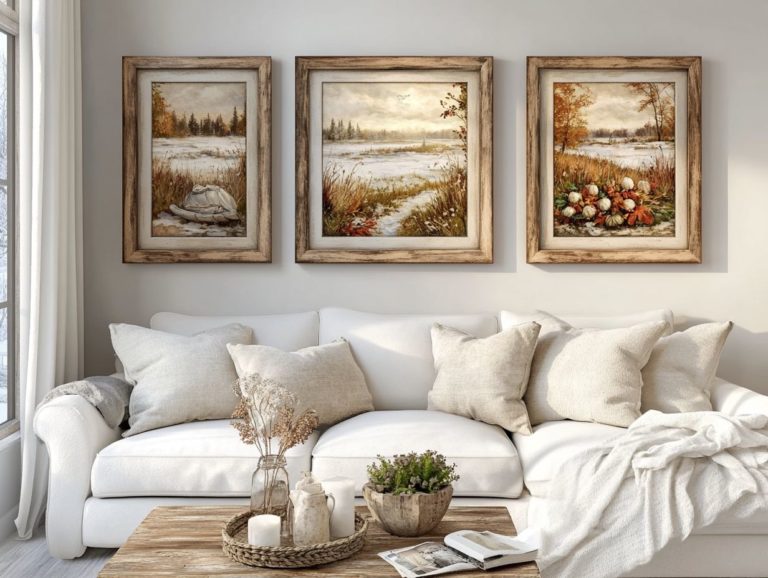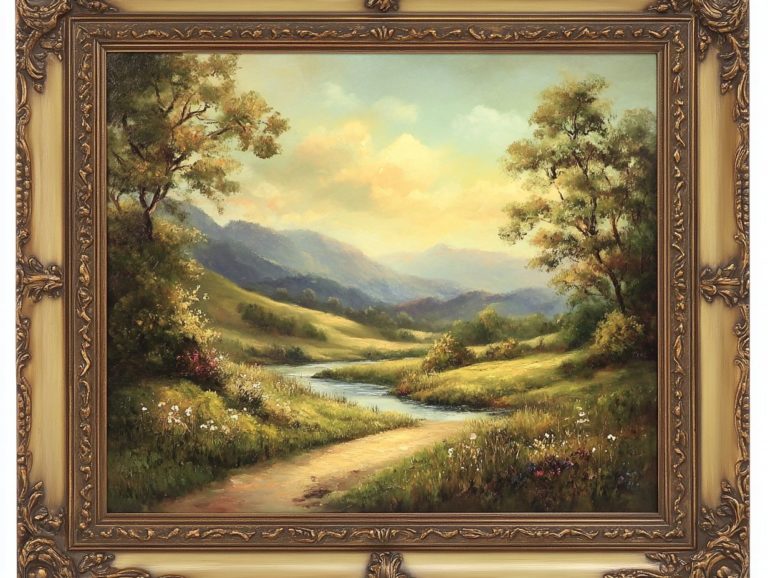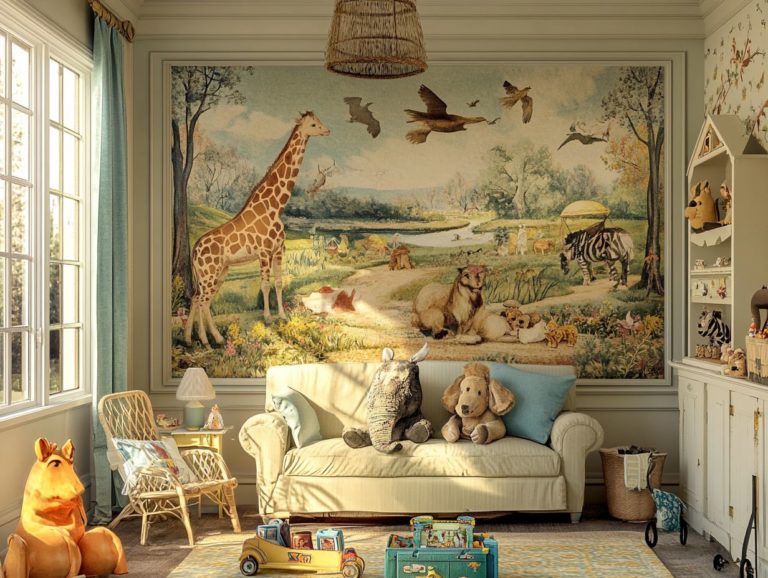The Evolution of Vintage Wall Art Styles
Vintage wall art features a rich history that beautifully mirrors cultural shifts and artistic movements throughout the decades.
From the opulence of Art Deco to the playful spirit of Retro, each style unfolds a unique narrative shaped by its era. This piece delves into the origins and evolution of vintage wall art, highlights popular styles, and offers insights on seamlessly integrating these timeless treasures into your contemporary decor.
It also provides guidance on collecting and caring for your own vintage finds.
Whether you re an art enthusiast or simply looking to elevate your space, find out how vintage wall art adds character and charm to your home!
Contents
- Key Takeaways:
- The History of Vintage Wall Art
- Popular Vintage Wall Art Styles
- Incorporating Vintage Wall Art into Modern Decor
- Collecting and Caring for Vintage Wall Art
- Frequently Asked Questions
- What is the significance of vintage wall art styles?
- How have vintage wall art styles evolved over time?
- What are some popular vintage wall art styles?
- How can one incorporate vintage wall art styles into their home decor?
- Are vintage wall art styles still relevant in modern times?
- Where can one find authentic vintage wall art?
Key Takeaways:

- Vintage wall art features a rich history and cultural influences, making it a unique addition to any interior design, showcasing design trends that have evolved from the 1960s to the 1980s.
- Art Deco, Mid-Century Modern, Art Nouveau, and Retro are some of the most popular vintage wall art styles known for their distinct characteristics and visual attraction.
- Incorporating vintage wall art into modern decor can create a unique and personalized look, making use of vibrant colors and bold elements from various art movements. Mixing styles and properly caring for pieces can keep them in great condition for years to come.
The History of Vintage Wall Art
The history of vintage wall art is an exciting story, tracing the influences of various art movements and cultural shifts in graphic design from the mid-20th century to the present day, particularly through the lens of pop art and graphic design style. It combines various styles, including Art Deco, Art Nouveau, and retro themes, each mirroring the societal trends and emotional resonance of their times.
Design aesthetics changed as visual communication grew, paving the way for a resurgence of nostalgia-driven pieces that speak to those yearning for the past. Iconic brands like Nike, Pepsi, and even Gucci have artfully harnessed these design elements, elevating their marketing campaigns in the process.
Origins and Influences
The origins and influences of vintage wall art are a fascinating blend of retro graphic design, art movements, and cultural phenomena that rose to prominence in the 1960s and 70s, especially through the vibrant lens of pop art and the psychedelic design that characterized those decades.
This blend changed how we see art and stirred emotions, as you found yourself captivated by the vibrant colors and playful forms that defined this era. Graphic design during this time was significantly influenced by movements like surrealism and minimalism, layering complex meanings onto seemingly simple imagery. Those captivating visuals evoke a strong sense of nostalgia, allowing you to connect deeply with your own memories.
Today s designers often look back on these historical aesthetics, infusing their modern projects with the boldness and whimsy that characterized those earlier decades. This approach allows them to maintain the emotional resonance of these styles while skillfully adapting them to contemporary tastes.
Popular Vintage Wall Art Styles
When exploring vintage wall art styles, you’ll encounter iconic movements like Art Deco, Mid-Century Modern, and Art Nouveau. Each of these styles boasts distinctive design elements and aesthetics that not only capture the essence of their respective eras but also continue to shape contemporary graphic design and design trends today.
Art Deco
Art Deco is a visually captivating design style! It features bold colors, geometric shapes, and luxurious materials.
This style emerged in the early 20th century, especially after World War I. It blends traditional craftsmanship with modern innovation, reflecting society’s optimism.
The sleek lines and rich textures found in vintage pieces, such as a stunning Art Deco mirror or an intricately designed vase, perfectly encapsulate the era s flair for sophistication.
Contemporary designers draw inspiration from this iconic style, crafting fresh interpretations that honor its rich history while resonating with today s aesthetic sensibilities. By incorporating Art Deco elements into your decor, you infuse elegance into your space and highlight the enduring relevance of this timeless style.
Mid-Century Modern

Mid-Century Modern is a design movement that found its footing in the mid-20th century. It is distinguished by clean lines, organic forms, and a seamless blend of how things look and work, often enhanced by vibrant colors and retro typography.
This iconic style has transformed architecture and furniture design, extending its influence into graphic and wall art. It crafts a visual language that captivates today, echoing the music influences that characterized the era.
It embodies a spirit of optimism and innovation, reflecting the post-war era’s yearning for simplicity and a connection with nature. The movement s focus on minimalism evokes nostalgia for a time when design prioritized user experience, appealing to contemporary sensibilities that crave both beauty and utility.
As a result, its elements resonate profoundly with those who appreciate the interplay of past and present, including influences from 50s to 90s design, within their living spaces.
Art Nouveau
Art Nouveau is a distinctive vintage design style that captivates with its intricate graphic elements, flowing lines, and natural motifs. It creates an organic aesthetic that continues to influence modern artistry and today’s design trends.
This artistic movement flourished between the late 19th and early 20th centuries and celebrates nature at its finest. Elements like flowers, leaves, and curving forms are interwoven to evoke a sense of harmony and elegance.
Craftspeople of the time strived to elevate everyday objects through their artistry, resulting in creations that are both functional and visually striking.
When it comes to vintage wall art, look no further than the stunning lithographs of Alphonse Mucha. His ornate designs feature beautiful women adorned with floral patterns that enchant the eye.
Then there s the elegant woodwork of Gustav Klimt, renowned for his intricate use of gold leaf and detailed patterns, exemplifying the craftsmanship that defines this beloved style.
Retro
Retro graphic design captures the essence of nostalgia! It invites you to experience vibrant colors, bold designs, and playful themes that resonate with your desire for a connection to the past.
This nostalgic appeal celebrates various design movements, from the bold lines of the Art Deco era to the vivid patterns of the 70s psychedelic scene. By weaving together elements like vintage typography, iconic motifs, and a touch of whimsy, retro aesthetics transform into a compelling storytelling tool, as detailed in the history of vintage wall art.
In today s marketing landscape, brands increasingly embrace these retro themes to tap into your emotional connections, stirring feelings of warmth and familiarity. This strategy engages you as a consumer and reinforces brand identity, infusing campaigns with a sense of timelessness and authenticity that resonates deeply.
Incorporating Vintage Wall Art into Modern Decor
Incorporating vintage wall art into your modern decor requires a discerning touch! It harmonizes design aesthetics with contemporary sensibilities. This thoughtful approach ensures that each piece enhances your space, adding character and depth without overwhelming the overall ambiance.
Explore vintage wall art to find unique pieces that reflect your style and enhance your living environment!
Tips and Ideas for Mixing Styles
Mixing vintage wall art with modern elements can truly transform your living space into something uniquely dynamic. A few thoughtful tips can guide you in achieving that harmonious blend.
To seamlessly integrate these styles, start by creating a cohesive color palette. This palette should tie together vintage and contemporary pieces.
Choose art that includes colors from your modern decor. This way, your vintage items will feel like a natural extension of your overall design.
Strategic placement can significantly enhance visual interest. Consider clustering smaller vintage pieces in a gallery wall format while letting larger contemporary works stand alone as striking focal points.
This approach not only fosters balance but also showcases the beauty of each piece, allowing them to shine in your curated space.
Collecting and Caring for Vintage Wall Art
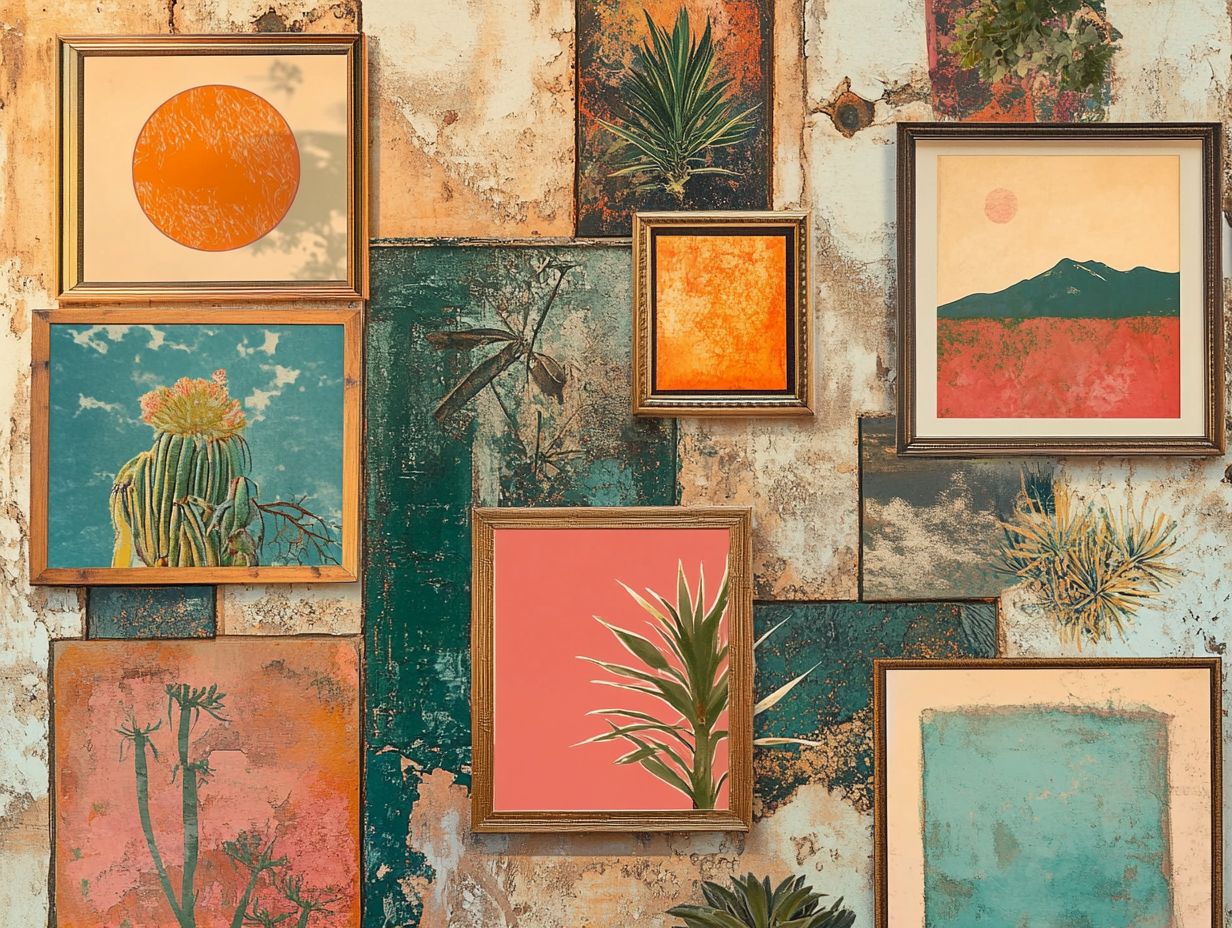
Collecting vintage wall art is an exciting journey. It invites you to explore and discover unique pieces that tell a story while focusing on preservation and sourcing authentic pieces that resonate with your personal taste.
Where to Find Pieces
Finding vintage wall art requires you to explore various sourcing avenues. Check out bustling marketplaces, charming galleries, and online platforms dedicated to retro designs, vintage posters, and nostalgia-driven pieces.
Delving into local flea markets, antique shops, and estate sales can unveil hidden gems, each with its unique story waiting to be discovered.
It’s crucial to examine the quality of work and materials used, as these elements significantly impact both authenticity and value. Look for signatures, labels, or provenance; they can offer valuable insights into the piece’s background.
Beyond physical locations, digital marketplaces like Etsy and eBay are treasure troves featuring vendors who specialize in vintage collections. Engaging with reputable sellers and perusing reviews can assure you that the artwork resonates with your personal taste and is genuine.
Proper Maintenance and Preservation
Proper maintenance and preservation of vintage wall art are essential for ensuring its longevity and retaining the emotional resonance these pieces hold. This requires careful handling and specific techniques that you should master.
Familiarize yourself with various preservation methods. For instance, storing your art in a climate-controlled environment can significantly reduce the risk of damage from humidity and temperature fluctuations.
When cleaning, use a soft, dry cloth to remove dust without harming the surface. Display your art away from direct sunlight to prevent fading.
Using archival-quality frames and UV-protective glass enhances protection and elevates the aesthetic appeal of your collection.
Establishing a routine inspection schedule allows you to catch any damage early, ensuring timely interventions that keep the vintage charm of your pieces intact.
Frequently Asked Questions
What is the significance of vintage wall art styles?
Vintage wall art styles are important as they provide a glimpse into the past. They reflect cultural and artistic movements and add a nostalgic touch to any space.
How have vintage wall art styles evolved over time?
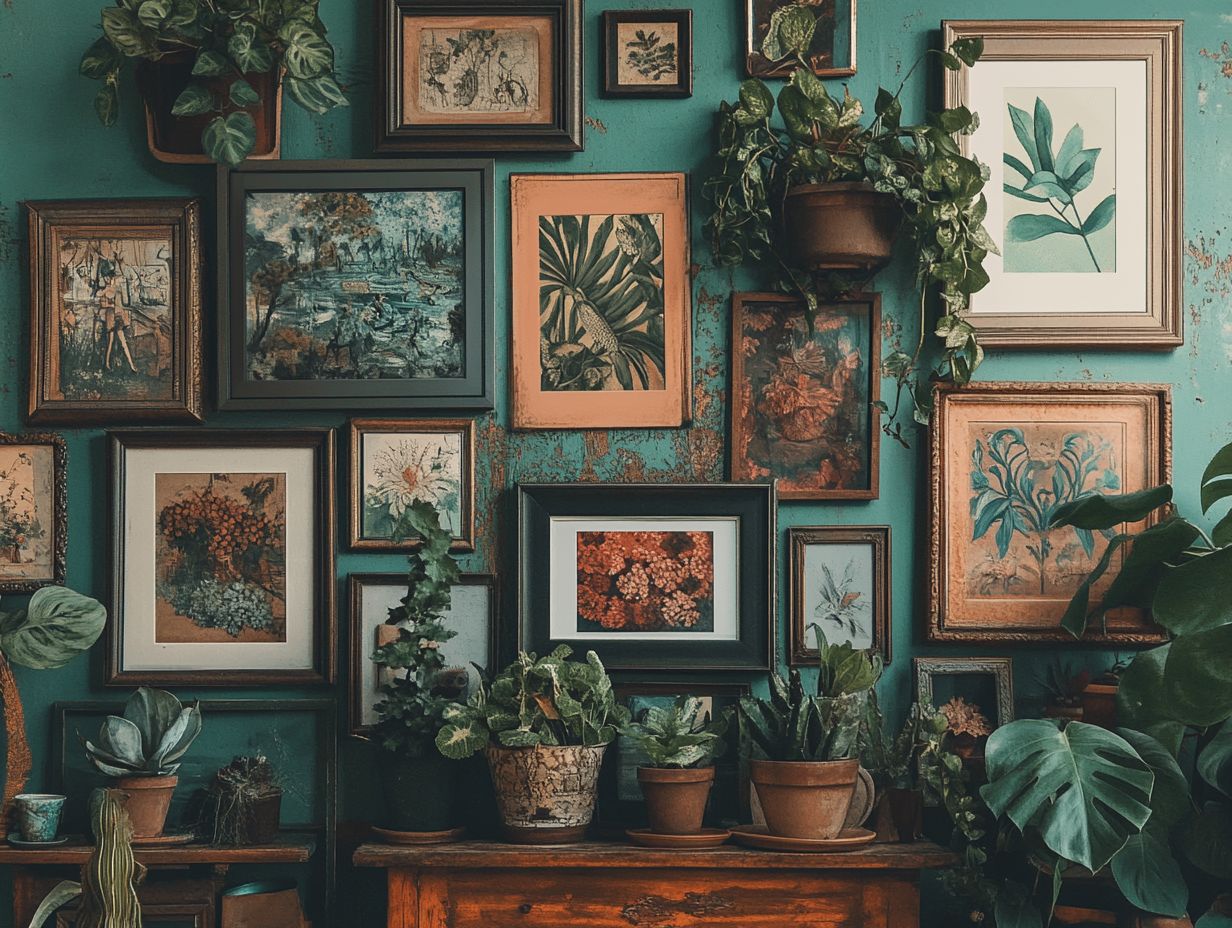
Vintage wall art styles have changed with trends in art and design. From Art Deco and Art Nouveau in the early 20th century to Mid-Century Modern in the 1950s, each era showcases unique styles.
What are some popular vintage wall art styles?
Popular vintage wall art styles include Art Deco, Victorian, Retro, and Pop Art. Each one has distinct features that make it recognizable.
How can one incorporate vintage wall art styles into their home decor?
You can bring vintage styles into your home in many ways. Mix and match styles for a varied look, or focus on one era for a cohesive theme.
Adding vintage frames or displaying vintage posters are fantastic options!
Are vintage wall art styles still relevant in modern times?
Vintage wall art styles remain relevant today. They continue to inspire contemporary art and design while adding charm to homes.
Where can one find authentic vintage wall art?
Authentic vintage wall art can be found in antique shops, flea markets, and online marketplaces. Make sure to research carefully to ensure authenticity before buying.

